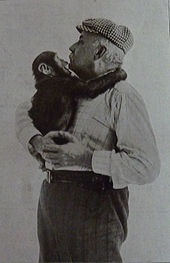Richard Lynch Garner
Richard Lynch Garner (born February 19, 1848 in Abingdon (Virginia) , † January 22, 1920 in Chattanooga (Tennessee) ) was an American zoologist who was particularly concerned with the language of monkeys. He used a phonograph by Thomas Alva Edison , among other things . Garner was convinced that humans and monkeys can communicate with each other by language. One of his favorite research subjects was the chimpanzee Susie.
Life
At the age of fourteen, Garner entered the Third Tennessee Mounted Infantry. He later trained at the Jefferson Institute in Tennessee . On October 15, 1872, he married Margaret E. Gross. From 1876 to 1890 he worked as a teacher. In 1884 he visited a zoo, the Cincinnati Zoological Garden , for the first time in his life . From this time on his interest in the sounds of monkeys was aroused. He started making recordings with the phonograph.
In 1892/93 he went on a research trip to the Congo and West Africa. He lived in a wire mesh cage for three and a half months and made sound recordings of the monkeys uttering sounds. It was able to “translate” 25 to 30 signals. From these studies his book The Speech of Monkeys emerged. He later wrote Apes and Monkeys .
In 1896 he conducted research on chimpanzees and gorillas living in the wild in Gabon .
From the same year comes his suggestion to present primates in zoos in open enclosures that should reproduce their actual habitats as closely as possible. But it wasn't until 1978 that the Woodland Park Zoo in Seattle realized this idea.
Garner had already taken his first expeditions to Lake Fernan Vaz. From 1905 he owned a house on an island in this lake.
On June 6, 1919, the New York Times published an article with the spectacular headline: "Garner Found Ape That Talked to Him." The newspaper reported that Garner had returned on the Chicago ship from an expedition to French Congo that lasted two years and seven months. During this time he put together around 3,000 pieces for the Smithsonian Institution and also made the acquaintance of a creature whom he described as a cross between a gorilla and a chimpanzee and which he said was able to communicate with the locals. He himself was able to talk to these animals in monkey language, but unfortunately did not bring a living specimen home with him. This expedition was to be his last. Richard Lynch Garner died in early 1920.
His estate was passed on by Garner's son Henry to John P. Harrington , who compiled Garner's biography in 1941. Together with Harrington's estate, it was then placed in the National Anthropological Archives. Harrison saw Garner's theories confirmed by the later research of Robert Yerkes .
Works
- Psychoscope , 1891
- The Speech of Monkeys , New York (CL Webster and Company) 1892
- Gorillas and Chimpanzees , London (Osgood, McIlvaine & Co.) 1896
- Apes and Monkeys , Boston and London (Ginn) 1900/1905
- Autobiography of a Boy. From the Letters of Richard Lynch Garner , introduction by Ales Hrdlicka, Washington (Huff Duplicating Co.), circa 1930
Web links
- Notes on life and estate (PDF file; 249 kB)
- Apes and Monkeys (wrong life dates at the beginning)
Individual evidence
- ↑ http://www.jstor.org/pss/4028063
- ↑ http://www.bsls.ac.uk/?page_id=436
- ↑ Archived copy ( memento of the original from April 26, 2009 in the Internet Archive ) Info: The archive link was inserted automatically and has not yet been checked. Please check the original and archive link according to the instructions and then remove this notice.
- ↑ http://www.grin.com/e-book/104141/spracherwerb-bei-schimpansen
- ↑ http://www.joncoedesign.com/pub/PDFs/SearchEden1987.pdf
- ↑ http://query.nytimes.com/mem/archive-free/pdf?_r=1&res=9B02E5DC1F39E13ABC4E53DFB0668382609EDE
- ↑ Archived copy ( Memento of the original from June 10, 2010 in the Internet Archive ) Info: The archive link was inserted automatically and has not yet been checked. Please check the original and archive link according to the instructions and then remove this notice.
| personal data | |
|---|---|
| SURNAME | Garner, Richard Lynch |
| ALTERNATIVE NAMES | Garner, RL |
| BRIEF DESCRIPTION | American monkey language researcher |
| DATE OF BIRTH | February 19, 1848 |
| PLACE OF BIRTH | Abingdon, Virginia |
| DATE OF DEATH | January 22, 1920 |
| Place of death | Chattanooga, Tennessee |


